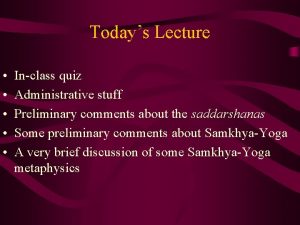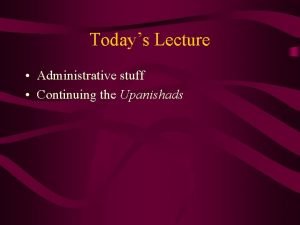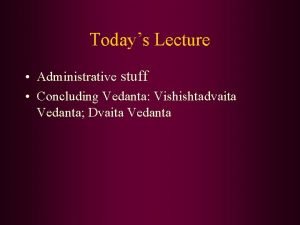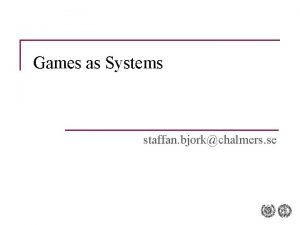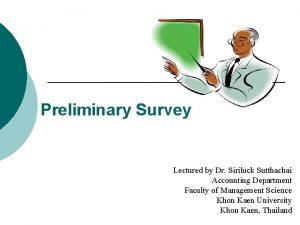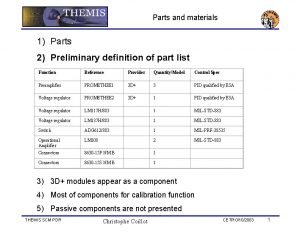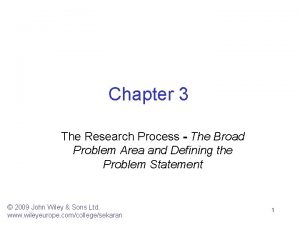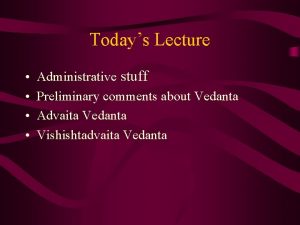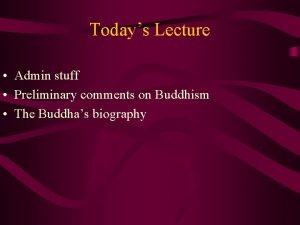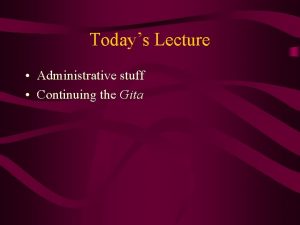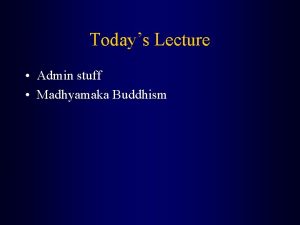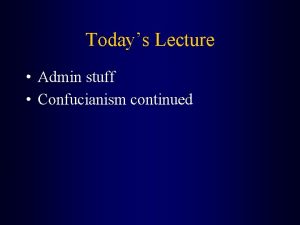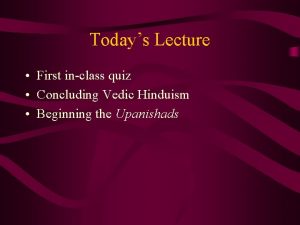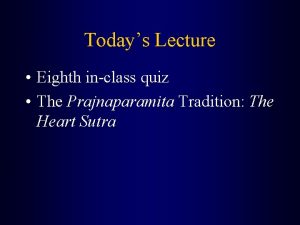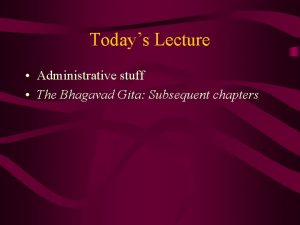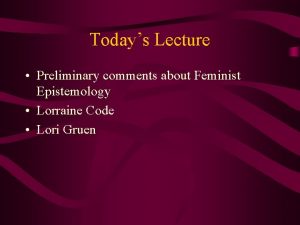Todays Lecture Inclass quiz Administrative stuff Preliminary comments









![Samkhya • Though prakriti is originally one, purusha is many. “[T]he Ultimate Self of Samkhya • Though prakriti is originally one, purusha is many. “[T]he Ultimate Self of](https://slidetodoc.com/presentation_image/f317189543206fdef4788479ba0c8491/image-10.jpg)










- Slides: 20

Today’s Lecture • • • In-class quiz Administrative stuff Preliminary comments about the saddarshanas Some preliminary comments about Samkhya-Yoga A very brief discussion of some Samkhya-Yoga metaphysics

Administrative stuff • The spreadsheet containing your overall grades so far will go online later today. Just go to the course site and follow the relevant link. If there is any discrepancies I should know about, please let me know. • You can pick up your graded assignments at the end of class. • For those who picked up their assignments on Friday, I have copies of the grading legend that you can pick up at the end of class. • There are still nine of you who have not submitted your first assignment to Turnitin. I’m afraid I can’t hand your assignments back until you submit them to that site.

Administrative stuff • I’ll have some very general comments about the assignments at the beginning of next class. For now note the following. (1) This assignment is the first of four, and is only worth ten percent of your overall grade. So if you received a low mark don’t lose heart. (2) I have given you extensive comments on your assignments, please look them over. The comments will help you with your next assignment. (3) If you think the mark is unreasonable after looking over my comments, come and see me. We can talk about it. I have been known to change grades, though you have to make a good case for it.

Some preliminary comments about the saddarshanas • The sad (or six) darshanas (views, theories, or philosophical systems) are, in large part, philosophical explorations of such basic issues as the nature of the empirical world, the nature of the constituents that make up the mind independent world (if there is one), the nature of knowledge, the nature of truth, the nature of the self, the nature of moksha, and the optimal path to moksha (Koller, Asian Philosophies, p. 6). • Though each darshana differs, sometimes significantly, on epistemological or metaphysical matters, they share a recognition of the authority of the Vedas and a desire to demonstrate that their central claims cohere with those found in the Vedic scriptures (Koller, Asian Philosophies, p. 6).

Some preliminary comments about the saddarshanas • Remember that these philosophical systems of thought have significant religious import. Each has the explicit aim of facilitating liberation from samsara, or ending the suffering associated with embodied existence (Koller, Asian Philosophies, pp. 8, 9, 10). • These philosophies, then, are an integral part of Hindu practice to those who hold them. • Do remember that each system tends to see itself as the best path to liberation.

Some preliminary comments about the saddarshanas • It is traditional to divide the six darshanas into three pairs: Samkhya-Yoga, Vaisheshika-Nyaya and Mimamsa-Vedanta. • This reflects the view that each pair shares certain key metaphysical or epistemological tenets or teachings in common (see Koller, Asian Philosophies, p. 60, 67, 78). • You need to remember, however, that each system has an identity of its own, and its own history.

Some preliminary comments about Samkhya-Yoga • For all intents and purposes, the metaphysics of classical Yoga is shared with Samkhya. Contemporary Yoga is another matter. Contemporary practitioners typically hold a Vedantan metaphysics. • We will be limiting ourselves to Samkhya and classical Yoga.

Some preliminary comments about Samkhya. Yoga • Samkhya-Yoga are, fundamentally, dualist (Koller, Asian Philosophies, p. 54). That is, they believe that reality is fundamentally comprised of two kinds of stuff (as opposed to one kind, which would be Monism). • They believe that all that exists, or will exist, is, fundamentally, comprised of matter and/or consciousness (Koller, Asian Philosophies, pp. 54 -55, 82). • The world around us is the product of the ‘interaction between’ purusha (or ‘spirit’ or ‘consciousness’) and prakriti (‘matter’). Fundamentally, Purusha and prakriti alone make up reality (Koller, Asian Philosophies, p. 58).

Samkhya • Don’t confuse purusha with the Atman of the Upanishads. Though ‘atman’ is a Sanskrit term that can be used to refer to either the empirical self or the Ultimate self, we have been using it up to now to refer to the Ultimate Self (to reflect the emphasis in the Upanishads and the Gita). So although Samkhya will talk of atman, and sometimes mean by this purusha (at least when referring to each of our ultimate Selves), it is clearer for our discussion to limit ourselves to talk of purusha.
![Samkhya Though prakriti is originally one purusha is many The Ultimate Self of Samkhya • Though prakriti is originally one, purusha is many. “[T]he Ultimate Self of](https://slidetodoc.com/presentation_image/f317189543206fdef4788479ba0c8491/image-10.jpg)
Samkhya • Though prakriti is originally one, purusha is many. “[T]he Ultimate Self of each person is a purusha” (Koller, Asian Philosophies, p. 54). • This system, then, rejects the monism contained in the Upanishads and the monism that may be gleaned from a reading of the Bhagavad Gita. • We are not, according to Samkhya, essentially One (or essentially Brahman). • This speaks to my earlier cautionary comments about looking for a strong unifying theme in Hinduism.

Samkhya • How does Samkhya’s metaphysics find a place in Hinduism proper? • Take a look at the Gita again, this time with an eye for how someone might read a dualist metaphysics into certain passages. • Consider three passages in particular: 3: 26 -35; 5: 517; 13: 2 -34.

Samkhya • There are several reasons for why Samkhya adopt a dualist metaphysics. • (1) They do not want to deny the reality of the material world (Koller, Asian Philosophies, pp. 5455). • (2) They do not want to deny that there is also a seemingly non-material aspect to reality, namely consciousness (Koller, Asian Philosophies, pp. 5455, 59). • These two commitments already seem to commit Samkhya to a metaphysical dualism.

Samkhya • There are certain things about the world that Samkhya also do not want to deny. • (1) There animate and inanimate objects (broadly construed to include beings like us, and other terrestrial [or even extra-terrestrial] animals). • (2) Organisms have a number of features associated with their material nature, including their mentality (see Koller, Asian Philosophies, p. 58). • (3) Causal events, and so change, really take place (Koller, Asian Philosophies, p. 55).

Samkhya • (4) These events are not chaotic. Only certain events arise from the presence of certain objects or processes. This is best explained, according to Samkhya, as a transformation of the relevant causes. This transformation consists of a rearrangement of the constituent gunas that make up any given cause (be it an object or process) (Koller, Asian Philosophies, pp. 55, 56). • (5) The universe as we know it had a beginning, and gradually moved from simplicity to complexity over a long period of time (Koller, Asian Philosophies, p. 57). Sounds familiar.

Samkhya • From the beliefs that change, or causality, arise from the transformation of extant objects or processes, that the universe as we know it had a beginning, and that it evolved from simplicity to complexity over a long period of time, Samkhya conclude that the material constituents of the universe, the gunas, were at one time (albeit in the distant past) in a state of equilibrium (Koller, Asian Philosophies, p. 58).

Samkhya • Something, then, is needed to explain the disequilibrium that initiated the causal change that gave rise to the universe as we know it. This something must be something other than matter. . . enter purushas (Koller, Asian Philosophies, p. 58). • Samkhya suggest that the very proximity of purushas to prakriti somehow initiated the disequilibrium in question (Koller, Asian Philosophies, p. 58).

Samkhya • There is a cost to this suggested metaphysics. • If the very proximity of the purushas to prakriti somehow initiated the disequilibrium that began material evolution, then these purushas must be, by implication, separate or apart from prakriti. • Since these purushas are your and my fundamental Selves, you and I are not, contra first appearances, actually embodied (Koller, Asian Philosophies, pp. 58, 59 -60). • Let that sink in for a second or two.

Samkhya • There are certain things about conscious beings, including humans, that Samkhya do not want to deny. • (1) We are attached or averse to the sensations, events or objects of or in our experience. • (2) We can abandon these attachments or aversions. • (3) We are bound to samsaric existence (Koller, Asian Philosophies, p. 59).

Samkhya • (4) We can escape our bondage to samsaric existence. That is, we, as conscious beings, can, as conscious beings, escape samsaric existence. In other words, we can in some intelligible sense talk of our existence beyond samsara (Koller, Asian Philosophies, p. 59). • (4) means that we are not, in any substantial sense, our embodied selves. If we can transcend our embodiment entirely and remain, in some fundamental sense, us, we are not, in some substantial sense, any of our particular bodies, or accompanying psyche, in any given birth.

Samkhya • Moksha, or liberation from samsara is, for Samkhya, achieved through the realization that we are not, in fact, actually embodied. • By letting go of our attachments to embodiment, by letting go of our attachments to any given personal identity associated with a particular birth, we free ourselves from the suffering associated with samsaric existence. • As liberated purushas we realize our essential natures as free, conscious subjects (Koller, Asian Philosophies, p. 59).
 Administrative stuff
Administrative stuff Administrative stuff
Administrative stuff Vishishtadvaita vedanta
Vishishtadvaita vedanta Administrative stuff
Administrative stuff 01:640:244 lecture notes - lecture 15: plat, idah, farad
01:640:244 lecture notes - lecture 15: plat, idah, farad Preliminary budget
Preliminary budget Preliminary treatment adalah
Preliminary treatment adalah Preliminary survey audit
Preliminary survey audit Preliminary reference earth model
Preliminary reference earth model Preliminary design review example
Preliminary design review example Preliminary material
Preliminary material Mla format thesis statement
Mla format thesis statement Preliminary interview
Preliminary interview Broad problem area example
Broad problem area example Wilson company prepared the following preliminary budget
Wilson company prepared the following preliminary budget Isang blankong papel, pinakaunang pahina sa pananaliksik
Isang blankong papel, pinakaunang pahina sa pananaliksik Preliminary graphics examples
Preliminary graphics examples Goto/sdlc
Goto/sdlc Preliminary thesis examples
Preliminary thesis examples Preliminary rifle instruction
Preliminary rifle instruction Arrt preliminary score change
Arrt preliminary score change
